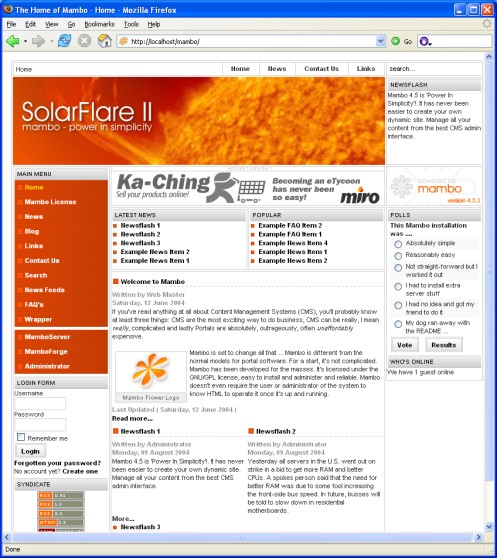Mambo is one of the most successful Content Management Systems (CMS) in the world today. It is based on PHP, one of the best web scripting languages, and is used on a vast number of websites today. Best of all, it is free. The community, however, was shaken when a large number of core developers of Mambo split their ways with Miro, the company that backed Mambo. The "rebels" went on to fork their version of the project, Joomla!, which has been developed independently.
For the end user, this is not yet a real problem. The current versions of Mambo and Joomla! are compatible with each other, so the contents of this book are valid for Joomla! as well. Once both Mambo and Joomla! release new major versions (Mambo 5, Joomla! 2, for instance), the packages will probably go in different directions and will require PHP5. However until then, both are a good bet, even if the Joomla! project seems to be more active currently.
In this book, we assume that you have already installed Mambo (or Joomla!) and played around with it—even configured your first sites, taking help from a basic introduction either in online form (like the online documentation) or in printed form (like Building Websites with Mambo ISBN 1-904811-73-6 published by Packt Publishing). Now, we assume that you want to go one step further. We do not want to guide you through the installation of the software but would like to show you how to get the most out of it, either by using some of the excellent extensions the community provides to its users, or by optimizing your Mambo site with your own code. This book discusses some of the best Mambo extensions, including e-commerce/online shopping, document management, and web forums. You will see examples of how to create your own extensions for Mambo/Joomla!, along with a detailed description of the process, unlike some of the other sources. Finally, this book touches other important advanced aspects of running a CMS, including performance, security, and accessibility.
This chapter once again repeats the important terminology of Mambo/Joomla! and steps through the front end and administration sections. We assume that you have chosen to use the default content during installation; otherwise, your Mambo/Joomla! site may look different (but behave quite similarly).
 |
Figure 1.1: The Mambo user interface with the example data
This is how the Mambo user interface would look without the example data:
 |
Figure 1.2: Mambo user interface without any example data



